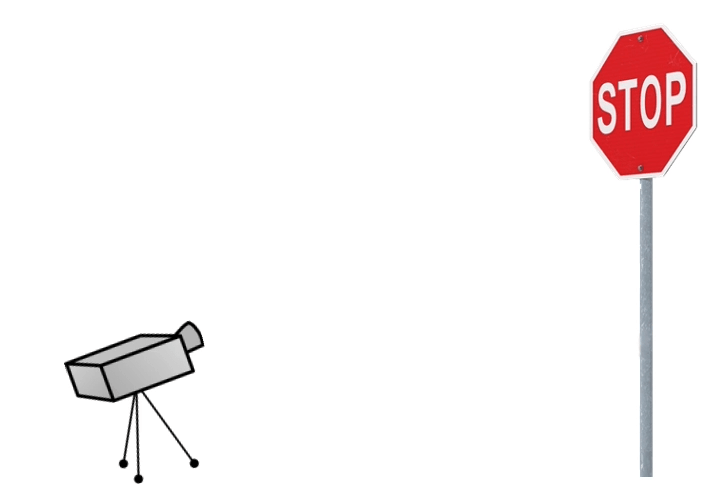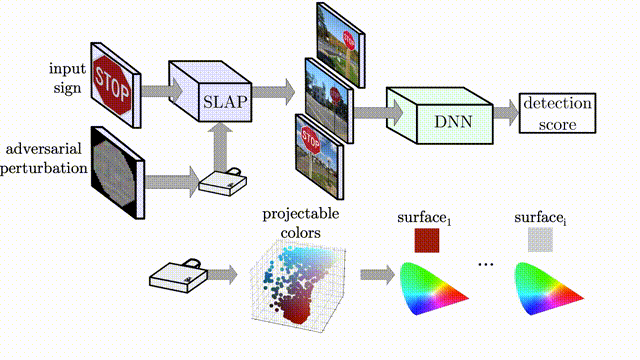Artifacts for the paper "SLAP: Improving Physical Adversarial Examples with Short-Lived Adversarial Perturbations" published in the 30th Usenix Security Symposium (2021).
We introduce a new attack vector to realize physical Adversarial Examples (AE): using a projector. By specifically optimizing the perturbation to project on a target object, we are able to create physical Adversarial Examples that fool deep neural networks for image classification and object detection.
We design an optimization pipeline that accounts for (1) the realizability of projected colours and (2) the robustness of the Adversarial Examples to environmental changes.
We test four different computer vision models: YOLOv3, MaskRCNN, LISACNN and GTSRBCNN, our implementations are available in this repository. SLAP in practice, targeting a Stop Sign:
The same pipeline can be applied to any target object class, here are examples of targeting class "Bottle" and class "Give Way":
See the conference presentation slides and Giulio's conference presentation video.
Data and models used in this paper are available in this release.
The data.zip folder will contain the following files:
. # data.zip
├── models # contains all models
│ ├── yolov3
│ ├── maskrcnn
│ ├── gtsrbcnn
│ │ │── cvpr18 # taken from cvpr18 paper
│ │ │── cvpr18iyswim # above with input randomization layer added
│ │ │── usenix21 # architecture from cvpr18 but re-trained
│ │ └── usenix21adv # above but trained with adversarial loss
│ └── lisacnn # same subfolders as gtsrbcnn
├── indoor # data used in indoors experiment
│ ├── objects # target objects cutouts
│ ├── profile # profiling data, used to fit projection model
│ │ │── 120/stop_sign/all_triples.csv # file used in 120 lux, for stop sign target
│ │ └── ...
│ └── optimize
│ │── 120/stop_sign/yolov3/_best_projection.png # projection image used for 120 lux, stop sign, yolov3 model
│ └── ...
├── outdoor # data used in outdoors experiment
└── datasets # image datasets used for re-training
├── gtsrb
└── lisa
This repository contains most of the code used in the paper. We also publish a Docker image containing the execution environment and data and models used in this work.
To use this repository, you will need docker, docker-compose and a GPU.
Make sure that the GPU is available within docker containers, (e.g., we had to
set "default-runtime": "nvidia" in /etc/docker/daemon.json).
Most of the code will also work on a CPU once you replace tensorflow-gpu with tensorflow==1.15.3;
if you do not have a GPU you can do this inside the container or rebuild it from a cpu-based image
(FROM tensorflow/tensorflow:1.15.3-py3-jupyter).
Follow these steps:
git clone https://github.com/ssloxford/short-lived-adversarial-perturbations.gitcd short-lived-adversarial-perturbations/wget https://github.com/ssloxford/short-lived-adversarial-perturbations/releases/download/usenix21/data.zipthedata.zipcontains models and data necessary to run tests.unzip data.zipdocker pull giuliolovisotto/short-lived-adversarial-perturbations:usenix21docker-compose up -ddocker attach slap_containernose2this runs a set of tests which verify that the basic functionalities run correctly.
One can check examples of usage by locally opening the notebook
the notebook example.ipynb
(the notebook is running inside the container and forwarded on this port).
The password is slap@usenix21.
You can also check the content of this notebook online example.ipynb.
If you use this repository please cite the paper as follows:
@inproceedings {272218,
author = {Giulio Lovisotto and Henry Turner and Ivo Sluganovic and Martin Strohmeier and Ivan Martinovic},
title = {{SLAP}: Improving Physical Adversarial Examples with Short-Lived Adversarial Perturbations},
booktitle = {30th {USENIX} Security Symposium ({USENIX} Security 21)},
year = {2021},
isbn = {978-1-939133-24-3},
pages = {1865--1882},
url = {https://www.usenix.org/conference/usenixsecurity21/presentation/lovisotto},
publisher = {{USENIX} Association},
month = aug,
}
This work was generously supported by a grant from armasuisse and by the Engineering and Physical Sciences Research Council [grant numbers EP/N509711/1, EP/P00881X/1].



